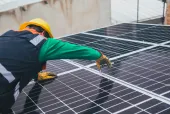
India reveals competitive bidding draft rules for wind projects
Comments will be received until April 21.
The Ministry of New and Renewable Energy (MNRE) has released draft guidelines for tariff-based competitive bidding process for wind power projects. The draft is open for comments up to April 21, 2017, according to Mercom Capital Group.
The overwhelming response received in the first ever wind tender of 1,000 MW by the Solar Energy Corporation of India (SECI) is one of the primary reasons behind the formulation of this draft. It has been under the wraps for some time now, according to an official at MNRE.
The introduction of bidding spurred activity in the wind sector. Now, all of the wind projects will be auctioned. The target is to achieve 6 GW of wind capacity addition every year and these guidelines will help expedite the entire process by removing ambiguities, added the MNRE official.
Here are key points from the proposal as compiled by Mercom Capital Group:
The developer will identify the land and submit lease and agreement documents within seven months of execution of power purchase agreement (PPA). The developer will arrange a no objection certificate, forest clearance certificate and a letter from state transmission utility or central transmission utility, confirming technical feasibility of connectivity of the project.
A single bidder will be allowed to bid for a minimum wind project capacity of 25 MW with at least 5 MW project at one site.
The procurer can also specify the maximum capacity to be allotted to a single bidder including affiliates. The maximum capacity for single bidder or company or group of companies can be fixed by the procurer taking into consideration economies of scale, land availability, expected competition timeframe, and the market need.
Tariffs quoted by the bidders must be within the bidding parameter. When there is a benchmark tariff, the bidder must quote below it.
The bidding can either be on fixed tariff in Rs./kWh for 25 years or on escalating tariff in Rs./kWh with a pre-defined annual escalations fixed in Rs./kWh for a specified number of years.
The procurer will have to disclose the applicable incentives in the RfS. The PPA period for all projects will be 25 years from the date of scheduled commissioning.
The declared capacity utilization factor (CUF) should not be less than 20 percent over a year. In the case where the project supplies energy less than the energy corresponding to the minimum CUF, the wind power generator will be liable to pay to the procurer a fine for the shortfall in availability of energy.
If the power generated is more than the maximum CUF, the generator is free to sell excess power to any other entity if the procurer refuses to buy the extra power generated.
Wind power projects have been accorded a must-run status and no commissioned wind power project can be asked to back down by a DISCOM or load dispatch center. In the situation of a backdown, except for the cases where the backdown is due to grid issues, the wind power generator will be eligible for generation compensation, from the procurer.
The distribution licensee (DISCOM) will provide payment security to the wind power generator through, a revolving letter of credit equivalent to one month’s average billing from the project under consideration and payment security fund suitable to support payment for at least three months’ billing of all the projects tied up with such fund.
The procurer can also provide a state government guarantee, ensuring there is adequate security to the wind power generator, both in terms of payment of energy charges and termination compensation.
A project will only be considered for partial commissioning when a minimum of 50 percent of the project is complete. When a project is commissioned early, the procurer will have to purchase the power generated at 75 percent of the PPA tariff until the specified commissioning date arrives.
All wind power projects should be commissioned within 15 months of PPA execution, however, wind projects with a capacity of 100 MW and above can be commissioned within 18 months of PPA execution.
The responsibility of getting transmission connectivity and access lies with the wind power generator and will be at the cost of wind power generator.













 Advertise
Advertise











